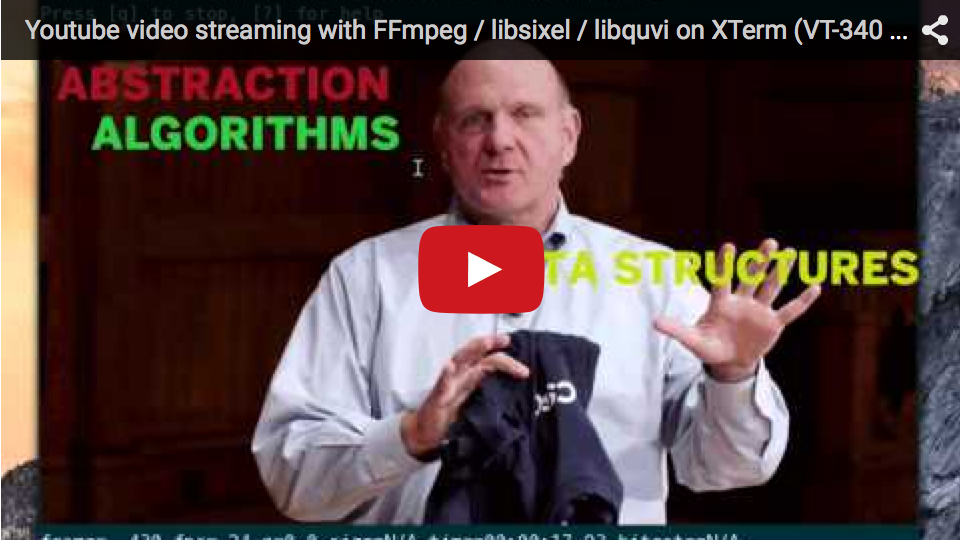FFmpeg is a collection of libraries and tools to process multimedia content such as audio, video, subtitles and related metadata.
libavcodecprovides implementation of a wider range of codecs.libavformatimplements streaming protocols, container formats and basic I/O access.libavutilincludes hashers, decompressors and miscellaneous utility functions.libavfilterprovides means to alter decoded audio and video through a directed graph of connected filters.libavdeviceprovides an abstraction to access capture and playback devices.libswresampleimplements audio mixing and resampling routines.libswscaleimplements color conversion and scaling routines.
- ffmpeg is a command line toolbox to manipulate, convert and stream multimedia content.
- ffplay is a minimalistic multimedia player.
- ffprobe is a simple analysis tool to inspect multimedia content.
- Additional small tools such as
aviocat,ismindexandqt-faststart.
- See the INSTALL file.
The offline documentation is available in the doc/ directory.
The online documentation is available in the main website and in the wiki.
Coding examples are available in the doc/examples directory.
FFmpeg codebase is mainly LGPL-licensed with optional components licensed under GPL. Please refer to the LICENSE file for detailed information.
Patches should be submitted to the ffmpeg-devel mailing list using
git format-patch or git send-email. Github pull requests should be
avoided because they are not part of our review process and will be ignored.
$ cat $HOME/.Xresources
XTerm*decTerminalID: vt340
XTerm*sixelScrolling: true
XTerm*regisScreenSize: 1920x1080
XTerm*numColorRegisters: 256
$ xrdb $HOME/.Xresources # reload
$ wget ftp://invisible-island.net/xterm/xterm.tar.gz
$ tar xvzf xterm.tar.gz
$ cd xterm-*
$ ./configure --enable-sixel-graphics
$ make
$ ./xterm # launch
Note: libquvi support has been removed from ffmpeg. To play youtube videos, you can use youtube-dl (or yt-dlp) to download a video, then you can play it with ffmpeg.
$ git clone https://github.com/libsixel/libsixel
$ cd libsixel
$ ./configure && make install
$ cd ..
$ git clone https://github.com/Albert-S-Briscoe/FFmpeg-SIXEL
$ cd FFmpeg-SIXEL
$ ./configure --enable-libsixel
$ make install
If you really don't want to make install a random fork of ffmpeg (which is an important dependency to a lot of programs), you can use this awful one-liner to generate another awful one-liner that will let you test ffmpeg-SIXEL. Just replace the ffmpeg command with the output. There's probably a better way, but here it is.
$ env a="$PWD" bash -c 'echo "env LD_LIBRARY_PATH=\"$a/libavfilter:$a/libavdevice:$a/libswresample:$a/libavcodec:$a/libswscale:$a/libpostproc:$a/libavutil:$a/libavformat:$LD_LIBRARY_PATH\" $a/ffmpeg"'
Play a video file:
$ ffmpeg -i videofilename -f sixel -pix_fmt rgb24 -s 480x270 -
If you want audio (and you use linux with pulseaudio), you can use this:
$ ffmpeg -i filename -f sixel -pix_fmt rgb24 -s 320x240 - -f alsa -ac 2 pulse
Play a YouTube video:
$ youtube-dl https://www.youtube.com/watch?v=dQw4w9WgXcQ -o tempvideo
$ ffmpeg -i tempvideo.mkv -f sixel -pix_fmt rgb24 -s 320x240 - -f alsa -ac 2 pulse
